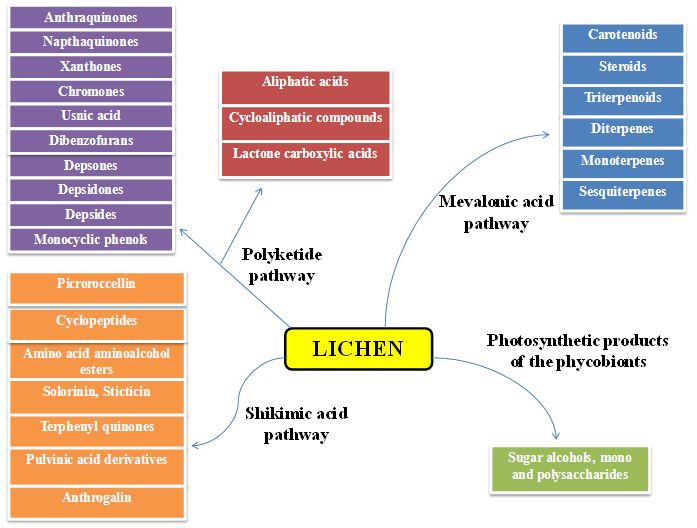 |
Sudarshan P. Bhat, Sumesh N. Dudani, M. D. Subhash Chandran and T. V. Ramachandra |
 |
LICHEN CHEMISTRY
The secondary chemicals produced by lichens have attracted the attention of investigators for over 100 years, and information about their structure, biogenic origin and phylogenetic significance has accumulated steadily over this period (Lawrey, 1986). Lichens synthesize a great variety of secondary metabolites, many of which are unique. Developments in analytical techniques and experimental methods have resulted in the identification of about 1050 lichen substances (Molnar et al, 2010). Most known lichen substances are usnic acid, phenolic compounds, anthraquinones, dibenzofurans, depsides, depsidones, depsones, triterpenes, gamma lactones and pulvinic acid derivatives and have a multiple biological activity: antiviral, antibiotic, antitumor, allergenic, plant growth inhibitory and enzyme inhibitory (Lawrey , 1995). Lichens had to evolve diverse biosynthetic pathways to produce such complex arrays of secondary metabolites. The polyketide biosynthetic pathway appears to be responsible for most of the classes of lichen compounds, whereas pulvinic acids are shikimate derivatives, and the abundance of di- and triterpenoids found in lichens are formed via the mevalonate pathway. There are large numbers of studies reporting the isolation and characterization of individual components of lichen extracts. The ability of certain lichen metabolites to reduce the mutagenicity of chemical mutagens has attracted moderate attention.
The depsidones, physodic and physodalic acid prevent the formation of reactive metabolites by blocking the oxidation systems present in the hepatic microsomal fraction (Osawa et al, 1991). The para-depside gyrophoric and diffractaic acid also inhibit the proliferation of human keratinocyte cells (Kumar & Muller, 1999b). Ursolic acid inhibited the growth of human epidermoid carcinoma cells by affecting tyrosine kinase activity (Hollosy et al, 2000). The use of ursolic acid for the manufacture of an anticancer agent for suppressing metastasis has been patented (Ishikawa et al, 1997). Yamamoto et al (1995) screened tissue cultures and thalli of lichens in search of some of the active lichen constituents for inhibition of tumor promoter induced Epstein-Barr virus activation. Ramalina hossei contains Usnic acid, sekikaic acid aggregates, tannins and terpenoids and the extracts of this lichen can be used as antifungal against Aspergilus niger and A.fumigatus (Kumar et al, 2010). Methanol extracts of Ramalina pacifica inhibits both Gram positive and Gram negative bacteria (Hoskeri, 2010). Species of Usnea contains high amount of Usnic acid, a very active lichen substance used as tumor inhibitor and as analgesic. Chloroform extracts of Roccella belangeriana exhibit antibacterial activity against Enterococci sp. (Karthikaidevi et al, 2009).

Fig.1 – Different Lichen substances and their biosynthetic pathways
Effects of Lichen substances on other organisms
Due to the increase in the new strains of multi drug-resistant pathogens, the standard drugs have become less effective, thereby increasing the demand for the search of novel natural bioactive compounds. In this backdrop, wide ranges of secondary metabolites of lichens are considered as a potential resource since these compounds function as chemical defense against biotic and abiotic stresses (Balaji & Hariharan, 2007). Lichen substances exhibit a great diversity of biological effects, including antimicrobial, antiinflammatory, analgesic, antipyretic, and antiproliferative and cytotoxic activities, and there has been a growing interest in the pharmaceutical properties of compound derived from lichens (Boustie & Grube, 2005). Burkholder et al (1944) reported for the first time the presence of antibiotic substances in lichens. Of late, many studies have been carried out to highlight the benefits of different properties of lichen substances.
The lichen thalli of Parmotrema praesorediosum were collected from the siliceous rocks in the Western Ghats of Tamil Nadu for studying the antimicrobial activity of its extracts (Balaji & Hariharan, 2007). The bioassay of the crude extracts from the lichen thalli were tested against pathogenic gram-positive, gram-negative bacteria and a fungi. The potential secondary metabolites of ethyl acetate and dichloromethane extracts were found to be active against the tested microorganisms.
Karthikaidevi et al (2009) collected Roccella belangeriana from the Pichavaram mangrove area; air dried it and soxhlated 10 gm of dried material with different solvents like diethyl ether, acetone, methanol, ethanol, ethyl acetate, petroleum ether, chloroform and water. The agar disc diffusion method employed in the study confirmed the presence and absence of antibacterial substances in the extracts of R. belangeriana against 12 pathogenic bacteria selected for the study.
Kumar et al (2010) collected the macrolichen Ramalina hossei from Bhadra Wildlife Sanctuary in central Western Ghats and obtained the solvent extracts from the powdered lichen material in different solvents namely methanol, acetone, chloroform, ethyl acetate and petroleum ether. The preliminary phytochemical analysis and thin layer chromatography of the extract showed the presence of the usnic acid and sekikaic acid aggregates, tannins and terpenoids. The antifungal efficacy and anthelmintic activity of the solvent extracts was tested and it was found that among the extracts tested, methanol extract produced marked inhibition of the test fungi followed by acetone extracts and others. The solvent extracts also exhibited a marked anthelmintic activity resulting in the paralysis and death of worms in dose dependant manner.
Kumar et al (2010) also collected another macrolichen Parmotrema pseudotinctorum from the forests of Bhadra WLS and analyzed its methanolic extract for antibacterial, anthelmintic and antioxidant activities. The preliminary phytochemical analysis of the abstract revealed the presence of tannins and steroids whereas the thin layer chromatography revealed the presence of Atranorin and Lecanoric acid. The extract was found to be exhibiting marked antibacterial activity and antioxidant activity in a dose dependant manner. The effects of the extract at the doses of 15 and 20 mg/ml, were comparable with that of standard anthelmintic.
The nutritive composition and insecticidal activity of the macrolichen Parmotrema pseudotinctorum collected from the forest area of Bhadra WLS was studied by Vinayaka et al (2010). The nutritive value of the lichen was found to be 336.1 cal/ 100 gm and it was found to possess high crude fibre, carbohydrate and protein content. The insecticidal activity of the lichen extract against the instar larvae of Aedes aegypti mosquito was found to be concentration dependent and the methanol extract showed a marked insecticidal activity than the other extracts. This study highlighted the possible use of this lichen in reducing problems associated with malnourishment and could also be used in the control of mosquitoes.
Hoskeri et al (2010) prepared the petroleum ether and ethanolic extracts of the lichen Ramalona pacifica collected from the forests of Bhadra Wildlife Sanctuary and assessed their antibacterial activity by agar well diffusion method against six different pathogenic bacterial strains. Both the extracts were found to be showing predominant antibacterial activity against all the multi-resistant strains with significant zone of inhibition at the Minimum Inhibitory Concentration (MIC) of 100 μl.
A foliose lichen Everniastrum cirrhatum belonging to the family Parmeliaceae, is mentioned in the Ayurveda as astringent, resolvent, aphrodisiac, carminative and laxative and was collected from the Bhadra WLS by Swathi et al (2010). The lichen material was dried, powdered, extracted in soxhlate apparatus with methanol as solvent and was subjected to tests for antibacterial, antifungal, anthelmintic and insecticidal activity. The preliminary phytochemical analysis of the extract showed the presence of alkaloids, saponins, tannins and terpenoids whereas thin layer chromatography showed the presence of Atranorin, Salazinic acid and Protolichesterinic acid. The extract showed a marked inhibitory activity against the gram positive bacteria than the gram negative bacteria and also showed a marked antifungal activity in a dose dependant manner. The extract also showed marked anthelmintic effect than the reference drug at the concentration of 5 mg/ml and higher.
| Back | Next |
